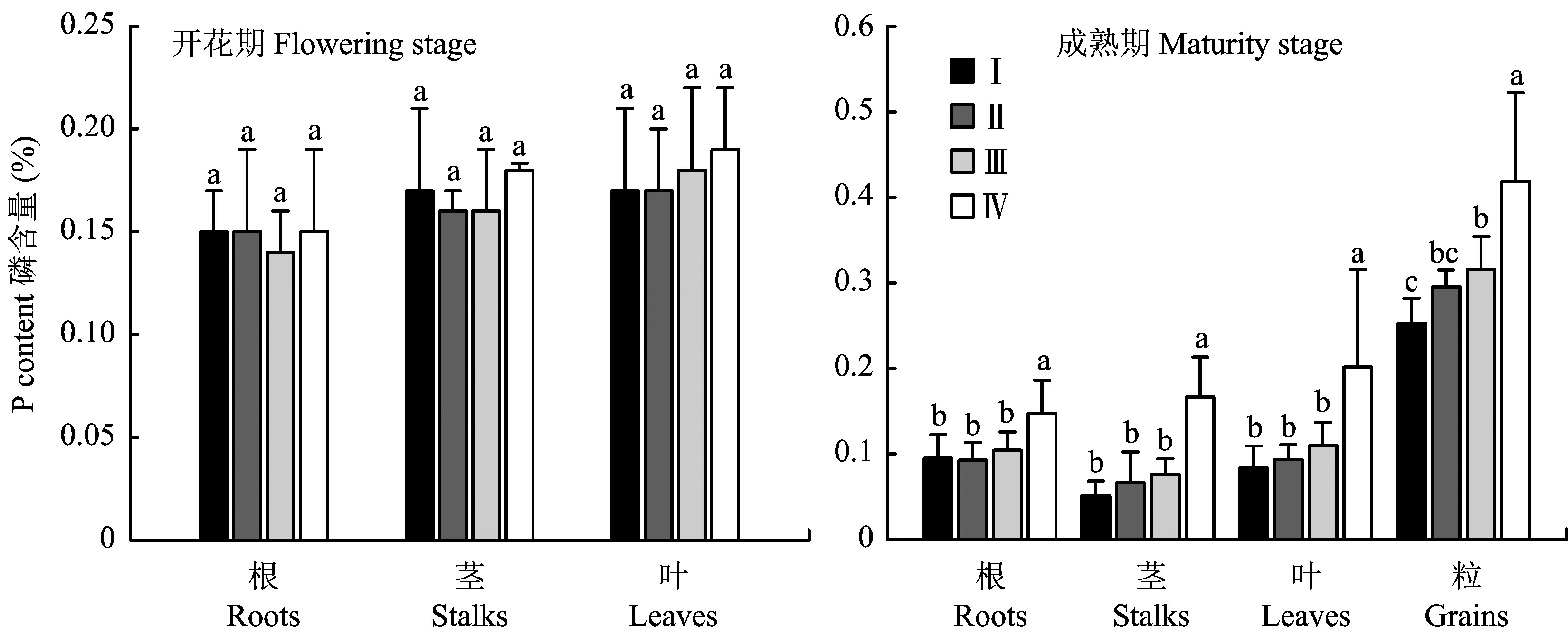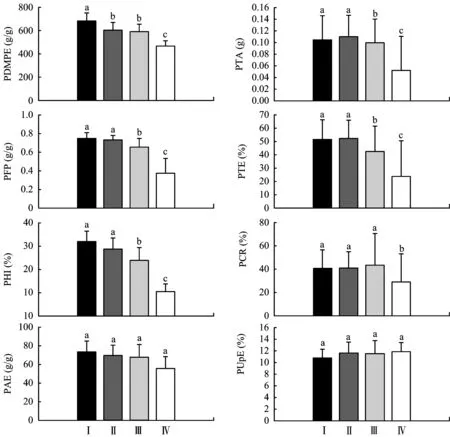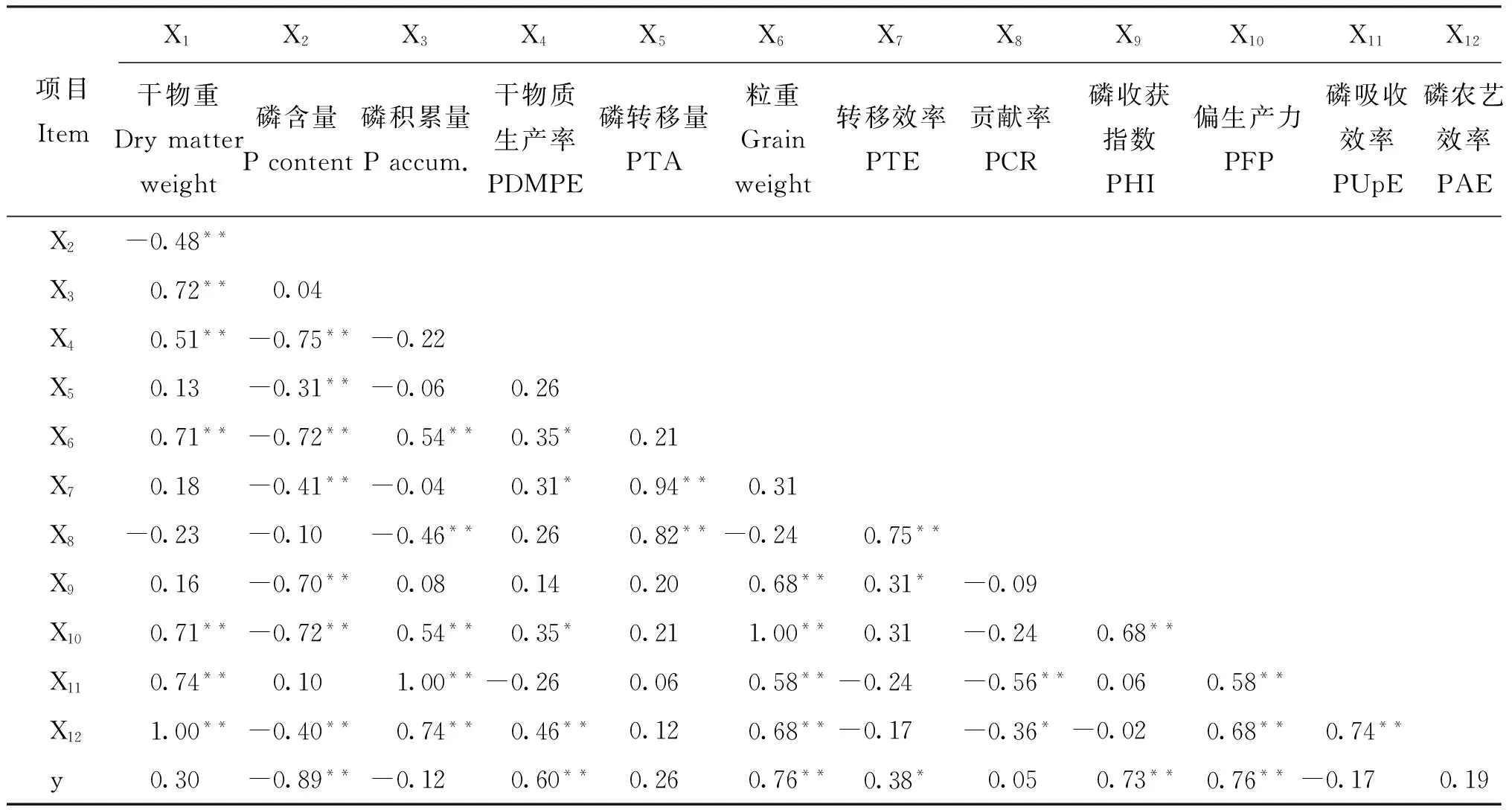我国北方40个高产春玉米品种的磷素利用特性
2015-06-15王晓慧曹玉军魏雯雯刘双利吕艳杰刘春光王永军王立春
王晓慧, 曹玉军, 魏雯雯, 刘双利, 吕艳杰, 刘春光,王永军*, 王立春*
(1吉林省农业科学院农业资源与环境研究所,玉米国家工程实验室,吉林长春 130033;2 吉林农业大学中药材学院,吉林长春 130118)
我国北方40个高产春玉米品种的磷素利用特性
王晓慧1, 曹玉军1, 魏雯雯1, 刘双利2, 吕艳杰1, 刘春光1,王永军1*, 王立春1*
(1吉林省农业科学院农业资源与环境研究所,玉米国家工程实验室,吉林长春 130033;2 吉林农业大学中药材学院,吉林长春 130118)
【目的】探明我国北方目前主推高产春玉米品种的磷素利用特性,揭示不同玉米品种磷素积累和转运差异,为磷高效品种的选育提供理论依据。【方法】选用东北区40个不同熟期的高产春玉米品种,在同一环境条件下采用盆栽试验,按照大田60000 plants/hm2种植密度进行摆放。在开花期和生理成熟期,每个品种取样3株,分成根、茎秆、叶片和子粒4部分,测定干物质重;采用钼锑抗比色法测定植株各器官磷含量;依据磷素子粒生产效率(PEPG)划分不同玉米品种的磷效率类型,计算磷素利用特性的相关参数;分析磷素利用特性相关参数与磷素子粒生产效率的关系。【结果】依据磷素子粒生产效率将供试玉米品种划分为4个类型,即磷高效型(I)、磷中效型(II)、磷低效型(III)及磷超低效型(IV)。其中,III型品种最多(45%),IV型品种最少(5%),II型和I型品种分别为27.5%和22.5%。在开花前4个类型品种的磷含量及磷素分配比例差异不显著,开花后是产生差异的关键时期。开花期,IV型品种茎秆的磷素积累量最高(P<0.05),I、II和III型品种根、茎秆和叶片的磷素积累量差异不显著(P>0.05)。成熟期,各器官的磷含量以IV型品种最高(P<0.05);II和III型品种的子粒磷含量高于I型品种(P<0.05),但II和III型品种的子粒磷含量差异不显著(P>0.05)。IV型品种根、茎秆和叶片的磷素积累量和分配比例较高(P<0.05),而I、II和III型品种子粒的磷素积累量和分配比例较高(P<0.05),I、II和III型品种根、茎秆、叶片和子粒的磷素积累量和分配比例无明显差异(P>0.05)。4个类型品种中,IV型品种的磷干物质生产效率(PDMPE)、磷收获指数(PHI)、磷偏生产力(PFP)、磷转移量(PTA)、磷转移效率(PTE)及磷贡献率(PCR)最低(P<0.05),I和II型品种的PFP、PHI、PTA及PTE显著高于III型品种(P<0.05),但I和II型品种的差异不显著(P>0.05);4个类型品种的磷素吸收效率(PUpE)和磷素农艺效率(PAE)无显著差异(P>0.05)。相关和通径分析表明,磷素干物质生产效率和粒重与磷素子粒生产效率呈显著正相关。【结论】我国北方目前主推的大部分高产春玉米为磷低效型品种;磷高效型品种在生育后期向子粒分配的磷素比例较多,而磷超低效型品种向根、茎秆和叶片分配的磷素比例较多;较高粒重和磷素干物质生产效率是磷高效型品种的基本特征。
高产春玉米; 磷素积累与分配; 磷素利用特性
磷素是玉米生长发育必需的大量营养元素之一,在提高玉米产量方面具有不可替代的作用[1-2]。但由于土壤中磷的有效性极低,缺磷已成为限制玉米进一步高产的主要因素之一[3]。依靠增施磷肥解决土壤中有效磷不足问题,不但导致玉米生产成本增加,而且造成环境污染风险加大,因此培育并推广磷高效玉米品种是促进磷素资源可持续利用的有效途径。北方春玉米区是我国最大的玉米产区,对全国粮食生产具有举足轻重的作用。其中,磷肥在提高玉米产量方面起到了关键作用[4]。

1 材料与方法
1.1 试验设计
在连续3年品种鉴选的基础上,本试验选用40个高产春玉米品种为供试材料(表1),其中包括吉林省8个、辽宁省8个、黑龙江省8个、内蒙古自治区11个、山西省5个。试验于2010年在吉林省农业科学院玉米试验基地种植,采用盆栽试验,盆高30 cm,直径30 cm,按照大田60000 plants/hm2种植密度进行摆放,行距55.5 cm,株距30 cm,每盆装干土25 kg。
供试土壤类型为黑土,有机质含量2.52%、全氮0.18%,全磷0.056%,全钾1.99%,速效氮184.27 mg/kg,速效磷17.54 mg/kg,速效钾137.60 mg/kg。每个品种种植6盆,共种植240盆,每盆播种3粒,三叶期间苗,五叶期定苗,每盆留苗1株。施用肥料为玉米专用肥(N ∶P2O5∶K2O=28 ∶18 ∶15),种肥7.14 g/plant,拔节期追肥4.47 g/plant,大喇叭口期追肥6.25 g/plant。重复3次,完全随机排列。生长期间保持充足的水分供应,其它管理与常规大田相同。

表1 供试玉米品种、代号、干物重及粒重(g/plant)
1.2 取样与测定方法
开花期和生理成熟期,每品种选取3株,分成根、茎秆(含穗轴和苞叶)、叶片、子粒4部分,75℃烘至恒重后分别称重,计算各器官干物质积累量。样品经粉碎过0.25 mm筛后,采用钼锑抗比色法测植株各器官含磷量[17]。
磷素利用特性相关指标通过下述公式计算:
磷素子粒生产效率(g/g)= 子粒重/整株磷素积累总量;
磷素干物质生产效率(g/g)= 整株干物重/整株磷素积累总量;
磷收获指数(%)= 子粒磷素积累量/植株磷素积累量×100;
磷转移量(g)= 植株开花期营养体磷素积累量-植株成熟期营养体磷素积累量;
磷转移效率(%)= 磷转移量/植株开花期营养体磷素积累量×100;
磷贡献率(%)= 磷转移量/子粒磷素积累量×100;
磷偏生产力(g/g)= 子粒产量/施磷量;
植株磷积累量(g/plant)= 不同部位干物重与磷浓度之积的总和;
磷吸收效率(%)= 植株磷素积累量/施磷量×100;
磷农艺效率(g/g)= 植株生物产量/施磷量。
1.3 数据处理与统计分析
采用Microsoft Excel 2003进行数据处理,DPS 12.0统计分析软件和SigmaPlot 10.0进行聚类、相关和通径分析及作图。
2 结果与分析
2.1 磷素子粒生产效率聚类分析
利用DPS多元分析对供试玉米品种磷素子粒生产效率进行聚类(表2),结果表明,供试春玉米品种可划分为4类:磷素高效型(I)、磷素中效型(II)、磷素低效型(III)和磷素超低效型(IV)。磷素高效型品种的磷素子粒生产效率比磷素中效型品种高20.15%,比磷素低效型品种高43.60%,比磷素超低效品种高240%;磷素中效型品种的磷素子粒生产效率比磷素低效型品种高19.52%,比磷素超低效品种高183%;磷素低效型品种比磷素超低效型品种高136.82%。40个品种中,I型品种占22.5%,II型品种占27.5%,III型品种占45.0%,IV型品种占5.0%。

表2 不同类型玉米品种的聚类分析
注(Note): PGPE—Phosphorus grain production efficiency. 同列数据后不同字母表示在0.05水平差异显著Data followed by the different letters are significantly different at the 0.05 probability level.
2.2 不同磷效率类型玉米的磷含量
开花期,4种磷效率类型品种的根、茎和叶的磷含量无显著性差异;成熟期,磷超低效型品种根、茎、叶及子粒的磷含量显著高于其他3类型品种,磷高效型品种、磷中效型品种和磷低效型品种根、茎、叶的磷含量无显著性差异,但磷高效型品种的子粒磷含量显著低于磷低效型品种,磷中效型品种的子粒磷含量与磷高效型品种和磷低效型品种无显著性差异(图1)。
2.3 不同磷效率类型玉米的磷积累与分配
开花期,4种磷效率类型品种根、叶的磷积累量无显著性差异,但磷超低效型品种茎杆的磷积累量显著高于其他类型品种(图2A);不同磷效率类型品种根、茎和叶的磷分配比例无显著差异(图2B)。

图1 开花期和成熟期不同磷效率类型玉米各器官磷素含量Fig.1 Phosphorus content in different organs of different hybrids at flowering stage and maturity stage[注(Note): Ⅰ—磷高效型 Phosphorus high efficiency; Ⅱ—磷中效型Phosphorus moderate efficiency; Ⅲ—磷低效型 Phosphorus low efficiency; Ⅳ—磷超低效型 Phosphorus super-low efficiency. 柱上不同字母表示在0.05水平上差异显著Different letters above the bars indicate significant differences at the 0.05 level.]

图2 开花期(A、B)和成熟期(C、D)不同磷效率类型玉米各器官磷素积累与分配比例Fig.2 Phosphorus accumulation and distribution in different organs of different hybrids at the flowering stage(A and B) and maturity stage(C and D)[注(Note):Ⅰ—磷高效型 Phosphorus high efficiency; Ⅱ—磷中效型Phosphorus moderate efficiency; Ⅲ—磷低效型 Phosphorus low efficiency; Ⅳ—磷超低效型 Phosphorus super-low efficiency. 柱上不同字母表示在0.05水平上差异显著 Different letters above the bars indicate significant differences at the 0.05 level.]
成熟期,根、茎和叶的磷积累量及分配比例以磷超低效型品种最高(P<0.05),子粒的磷积累量及分配比例以磷超低效型品种最低(P<0.05),磷高效型品种、磷中效型品种、磷低效型品种根、茎、叶和子粒的磷积累量及分配比例无显著差异(图2C、 D)。
2.4 不同磷效率类型玉米的磷素相关参数
磷超低效型品种的磷素干物质生产效率、磷收获指数、磷偏生产力、磷转移量、磷转移率及磷贡献率均显著低于其它3类型品种;磷高效型和磷中效型品种的磷收获指数、磷偏生产力、磷转移量及磷转移率显著高于磷低效型品种,但磷高效型和磷中效型品种无显著差异;磷高效型品种的磷素干物质生产效率明显高于磷中效型和磷低效型品种,磷中效型和磷低效型品种无显著差异;4类型品种的磷吸收效率和磷农艺效率差异不显著(图3)。

图3 不同磷效率类型玉米品种磷素相关参数Fig.3 Parameters related to phosphorus in different hybrids[注(Note): PDMPE—磷素干物质生产效率Phosphorus dry matter production efficiency; PTA—磷转移量Phosphorus transportation amount; PTE—磷转移效率Phosphorus transportation efficiency; PCR—磷贡献率Phosphorus contribution rate; PHI—磷收获指数Phosphorus harvest index; PFP—磷偏生产力Phosphorus partial productivity; PAE—磷农艺效率Phosphorus agronomic efficiency; PUpE—磷吸收效率Phosphorus uptake efficiency.Ⅰ—磷高效型Phosphorus high efficiency;Ⅱ—磷中效型Phosphorus moderate efficiency; Ⅲ—磷低效型 Phosphorus low efficiency; Ⅳ—磷超低效型Phosphorus super-low efficiency. 柱上不同字母表示在0.05水平上差异显著Different letters above the bars indicate significant differences at the 0.05 level.]
2.5 磷素效率与粒重等性状的关系
对40个玉米品种磷素子粒生产效率(y)及粒重等指标进行相关分析。结果表明,磷素子粒生产效率与磷利用特性各参数多呈显著相关(表3)。表明磷利用特性各参数对供试玉米品种的磷素子粒生产效率高低具有重要影响。

表3 成熟期不同类型玉米磷素子粒生产效率与粒重等性状的相关性
注(Note): PDMPE—Phosphorus dry matter production efficiency; PTA—Phosphorus transportation amount; PTE—Phosphorus transportation efficiency; PCR—Phosphorus contribution rate; PHI—Phosphorus harvest index; PFP—Phosphorus partial productivity; PAE—Phosphorus agronomic efficiency; PUpE—Phosphorus uptake efficiency. *和**分别表示在0.05和0.01水平显著Indicate significance at the 0.05 and 0.01 levels, respectively.
磷素利用特性参数指标与磷素子粒生产效率的通径分析表明,各指标的贡献率依次为:粒重>干物重>磷干物质生产效率>贡献率>磷转移量>磷收获指数>磷含量,粒重对磷素子粒生产效率的直接作用最大,与相关分析的结果表现一致。磷素干物质生产效率和粒重与磷素子粒生产效率存在真实一致的相关性,是影响磷素子粒生产效率的主要指标(表4)。

表4 成熟期粒重等性状对磷素子粒生产效率的通径分析
注(Note): PTA—Phosphorus transportation amount; PCR—Phosphorus contribution rate; PHI—Phosphorus harvest index; PDMPE—Phosphorus dry matter production efficiency.
3 讨论
适当增施磷素对于提高玉米产量具有重要作用[18]。但生产中为追求高产而大量施入磷肥,导致磷素生产效率下降,环境风险加大。选育磷高效型品种是解决上述问题的有效途径[19-21]。近年来,挖掘磷素高效吸收利用潜力进而提高玉米的磷素效率的研究备受关注。前人对不同玉米品种吸收和利用效率开展了较多研究[22-24],表明玉米磷效率的高低主要取决于玉米根系对磷的吸收效率和磷在玉米体内的利用效率,不同基因型玉米在磷吸收和利用方面存在明显差异。在苗期和拔节期,磷吸收效率是决定耐低磷玉米品种的主要变异来源;而正常施磷条件下,磷高效型自交系具有较大的磷素再利用能力。本试验以来自我国北方春玉米区当前主推的40个高产春玉米品种为材料,对供试玉米品种的磷素利用特性进行了研究。结果表明,通过对磷素子粒生产效率进行聚类分析,供试玉米品种划分为磷高效型、磷中效型、磷低效型和磷超低效型等4种类型。其中,磷素低效型品种所占比例最大(45%),磷素超低效型最小(5%),磷素高效型和磷素中效型所占比例分别为22.5%和27.5%。说明当前北方主推玉米品种大部分为磷素低效型品种,通过育种手段挖掘玉米的磷素子粒生产效率具有较大潜力。

对成熟期不同类型品种磷素子粒生产效率与粒重等农艺性状相关分析发现,磷素子粒生产效率与磷干物质生产效率、粒重、磷收获指数和磷偏生产力极显著正相关,与磷转移效率显著正相关,与磷含量极显著负相关;对磷素子粒生产效率的通径分析表明,磷素干物质生产效率和粒重与磷素子粒生产效率的相关性表现一致,表明该磷效率参数是影响磷素子粒生产效率的重要指标。
磷效率是磷素吸收、同化、运转、再利用等多个生理过程综合作用的结果,可分解为吸收效率和利用效率[28]。本试验结果表明,磷高效型品种在开花后具有较强的磷素转运能力及较高的磷素干物质生产效率。本研究探讨了磷素利用特性相关的磷素子粒生产效率、磷积累量、磷素干物质生产效率、磷对子粒的贡献率等磷效率参数与玉米磷效率的关系,有关北方地区高产玉米磷吸收效率相关参数表现特征及其与产量的关系尚有待进一步研究。
4 结论
我国北方高产春玉米品种在磷素子粒生产效率上分为磷高效、中效、低效和超低效4种类型。其中,磷超低效型品种比例最小,磷低效型品种比例最大。4类磷效率类型玉米品种开花后的磷素利用特性表现较大差异,表现为磷高效型品种的磷转移率、贡献率和输出率显著高于磷低效和磷超低效型品种。成熟期,磷高效型品种向子粒的分配比例较高,而磷低效型品种向根、茎和叶的分配比例较高。粒重和磷素干物质生产效率与磷素子粒生产效率呈极显著正相关,可作为磷高效玉米品种选育的参考指标。
[1] Mollier A, Pellerin S. Maize root system growth and development as influenced by phosphorus deficiency[J]. Journal of Experimental Botany, 1999, 50: 487-497.
[2] Barry D A J, Miller M H. Phosphorus nutritional requirement of maize seedling for maximum yield[J]. Agronomy Journal, 1989, 81: 95-99.
[3] 张玉兰, 王俊宇, 马星竹, 陈利军. 提高磷肥有效性的活化技术研究进展[J]. 土壤通报, 2009, 40(1): 194-202. Zhang Y L, Wang J Y, Ma X Z, Chen L J. Advances on activating technique research in improving the validity of phosphorus fertilizer[J]. Chinese Journal of Soil Science, 2009, 40(1): 194-202.
[4] 中华人民共和国国家统计局. 中国统计年鉴 [M]. 北京: 中国统计出版社, 2011. 458-465. National Bureau of Statistics of China. China statistics yearbook [M]. Beijing: China Statistics Press, 2011. 458-465.
[5] 高强, 冯国忠, 王志刚. 东北地区春玉米施肥现状调查[J]. 中国农学通报, 2010, 26(14): 229-231. Gao Q, Feng G Z, Wang Z G. Present situation of fertilizer application on spring maize in northeast China[J]. Chinese Agricultural Science Bulletin, 2010, 26(14): 229-231.
[6] 彭正萍, 张家铜, 袁硕, 等. 不同供磷水平对玉米干物质和磷动态积累及分配的影响[J]. 植物营养与肥料学报, 2009, 15(4): 793-798. Peng Z P, Zhang J T, Yuan Setal. Effects of different phosphorus application rates on the dynamic accumulation and distribution of dry matter and phosphorus in maize[J]. Plant Nutrition and Fertilizer Science, 2009, 15(4): 793-798.
[7] 范秀艳, 杨恒山, 高聚林, 等. 施磷方式对高产春玉米磷素吸收与磷肥利用的影响[J]. 植物营养与肥料学报, 2013, 19(2): 312-320. Fan X Y, Yang H S, Gao J Letal. Effects of phosphorus fertilization methods on phosphorus absorption and utilization of high yield spring maize[J]. Plant Nutrition and Fertilizer Science, 2013, 19(2): 312-320.
[8] Plenet D, Etchebest S, Mollier A, Pellerin S. Growth analysis of maize field crops under phosphorus deficiency[J]. Plant and Soil, 2000, 223: 119-132.
[9] 赵亚丽, 杨春收, 王群, 等. 磷肥施用深度对夏玉米产量和养分吸收的影响[J]. 中国农业科学, 2010, 43(23): 4805-4813. Zhao Y L, Yang C S, Wang Qetal. Effects of phosphorus placement depth on yield and nutrient uptake of summer maize[J]. Scientia Agricultra Sinica, 2010, 43(23): 4805-4813.
[10] 张立花, 张辉, 黄玉芳, 等. 施磷对玉米吸磷量、产量和土壤磷含量的影响及其相关性[J]. 中国生态农业学报, 2013, 21(7): 801-809. Zhang L H, Zhang H, Huang Y Fetal. Effects of phosphorus application on soil available phosphorus and maize phosphorus uptake and yield[J]. Chinese Journal of Eco-Agriculture, 2013, 21(7): 801-809.
[11] 明风, 米国华, 张福锁. 水稻对低磷反应的基因型差异及生理适应机制的初步研究[J]. 应用与环境生物学报, 2000, 6(2): 138-141. Ming F, Mi G H, Zhang F S. Studies on varietal difference of rice in response to low-P stress and its physiological adaptive mechanism[J]. Chinese Journal of Applied and Environmental Biology, 2000, 6(2): 138-141.
[12] Gaume A, Machler F, Leon C Detal. Low-P tolerance by maize(ZeamaysL.) genotypes: Significance of root growth, and organic acids and acid phosphatase root exudation[J]. Plant and Soil, 2001, 228: 253-264.
[13] Baker D E, Jarrell A E, Marshall L E, Thomas W I. Phosphorus uptake from soils by corn hybrids selected for high and low phosphorus accumulation[J]. Agronomy Journal, 1970, 62: 103-106.
[14] Gerloff G C. Intact-plant screening for tolerance of nutrient-deficiency stress[J]. Plant and Soil, 1987, 99: 3-16.
[15] 陈俊意, 蔡一林, 吕学高. 不同磷效率玉米基因型相对生物学指标和相对生理特性的差异[J]. 中国农学通报, 2007, 23(5): 239-242. Chen J Y, Cai Y L, Lü X G. Studies on the differences of relative biological index and relative physiologic characteristics in different phosphorus efficiency maize genotypes[J]. Chinese Agricultural Science Bulletin, 2007, 23(5): 239-242.
[16] Hajabbasi M A, Schumacher T E. Phosphorus effects on root growth and development in two maize genotypes[J]. Plant and Soil, 1994, 158: 39-46.
[17] 南京农业大学. 土壤农化分析 [M]. 北京: 中国农业出版社, 1988. 213-216. Nanjing Agricultural University. Analytical methods of soil and agricultural chemistry [M]. Beijing: China Agriculture Press, 1988. 213-216.
[18] Duvick D N. The contribution of breeding to yield advances in maize(ZeamaysL.)[J]. Advances in Agronomy, 2005, 86: 83-145.
[19] 陈范骏, 米国华, 春亮, 等. 玉米氮效率的杂种优势分析[J]. 作物学报, 2004, 30(10): 1014-1018. Chen F J, Mi G H, Chun Letal. Analysis of heterosis for nitrogen use efficiency in maize[J]. Acta Agronmica Sinica, 2004, 30(10): 1014-1018.
[20] Presterl T, Seitz G, Landbeck Metal. Improving nitrogen-use efficiency in European maize[J]. Crop Science, 2003, 43: 1259-1265.
[21] Hirel B, Gouis J L, Ney B, Gallais A. The challenge of improving nitrogen use efficiency in crop plants: towards a more central role for genetic variability and quantitative genetics within integrated approaches[J]. Journal of Experimental Botany, 2007, 58: 2369-2387.
[22] 陈俊意, 蔡一林, 徐德林, 等. 不同玉米基因型的磷效率和相对生物性状的差异及其回归模型研究[J]. 植物营养与肥料学报, 2007, 13(6): 1068-1073. Chen J Y, Cai Y L, Xu D Letal. Maize genotype differences in phosphorus efficiency and relative biological characteristics and regression modeling analysis[J]. Plant Nutrition and Fertilizer Science, 2007, 13(6): 1068-1073.
[23] 曹国军, 刘宁, 杜立平, 等. 高产春玉米产量及其构成与氮磷钾施用量关系研究[J]. 吉林农业大学学报,2008, 30(6): 830-833, 838. Cao G J, Liu N, Du L Petal. A study on the correlation between NPK application and the yield and yield components of high yield spring maize[J]. Journal of Jilin Agricultural University, 2008, 30(6): 830-833, 838.
[24] 佟屏亚, 凌碧莹. 夏玉米氮、磷、钾积累和分配态势研究[J]. 玉米科学, 1994, 2(2): 65-69. Tong P Y, Ling B Y. Accumulation and distribution of nitrogen, phosphorus and potassium in summer maize[J]. Journal of Maize Sciences, 1994, 2(2): 65-69.
[25] Schroeder M S, Janos D P. Plant growth, phosphorus nutrition, and root morphological responses to arbuscular mycorrhizas, phosphorus fertilization, and intraspecific density[J]. Mycorrhiza, 2005, 15: 203-216.
[26] 吴迪, 黄绍文, 金继运. 氮肥运筹、配施有机肥和坐水种对春玉米产量与养分吸收转运的影响[J]. 植物营养与肥料学报, 2009, 15(2): 317-326. Wu D, Huang S W, Jin J Y. Effects of nitrogen fertilizer management, organic manure application and bed-irrigation sowing on maize yield, and nutrient uptake and translocation[J]. Plant Nutrition and Fertilizer Science, 2009, 15(2): 317-326.
[27] 李文娟, 何萍, 金继运. 钾素营养对玉米生育后期干物质和养分积累与转运的影响[J]. 植物营养与肥料学报, 2009, 15(4): 799-807. Li W J, He P, Jin J Y. Potassium nutrition on dry matter and nutrients accumulation and translocation at reproductive stage of maize[J]. Plant Nutrition and Fertilizer Science, 2009, 15(4): 799-807.
[28] Moll R H, Kamprath E J, Jackson W A. Analysis and interpretation of factors which contribute to efficiency of nitrogen utilization[J]. Agronomy Journal, 1982, 74: 562-564.
Phosphorus utilization characteristics of forty spring maize hybrids with high-yielding potential in north of China
WANG Xiao-hui1, CAO Yu-jun1, WEI Wen-wen1, LIU Shuang-li2, LÜ Yan-jie1, LIU Chun-guang1,WANG Yong-jun1*, WANG Li-chun1*
(1InstituteofAgriculturalResourcesandEnvironment,JilinAcademyofAgricultureSciences/StateEngineeringLaboratoryofMaize,Changchun130033,China;2CollegeofChineseMedicinalMaterials,JilinAgriculturalUniversity,Changchun130118,China)
【Objectives】 A pot experiment was conducted to evaluate phosphorus utilization characteristics of different spring maize hybrids with high-yielding potential that are widely grown in north of China, to illustrate differences of phosphorus accumulation and transportation of different maize hybrids, and to provide scientific information for the high efficient breeding of phosphorus in maize. 【Methods】 Forty maize hybrids were cultivated in pots and planted in 60000 plants/hm2with the same environmental conditions. Three plants were selected in every hybrid at the flowering stage and maturity stage, and divided into four parts, roots, stalks, leaves and grains. Dry matter weight was measured after stoving. The phosphorus contents of different organs were determined with the colorimetric method. Phosphorus grain production efficiency(PGPE) was applied to divide the phosphorus efficiency of different maize hybrids. The related parameters of phosphorus utilization characteristics were calculated, and relationship between PGPE and related parameters of phosphorus utilization characteristics was analyzed. 【Results】 The results indicate that the maize hybrids can be classified into four types according to values of PGPE, including phosphorus efficiency of high(type I), moderate(type II), low(type III) and super-low(type IV). The much more number of cultivars were found in the type III(with a ratio of 45%), followed by the types II(27.5%) and I(22.5%), and the fewer number of cultivars were observed in the type IV, with a ratio of 5%. The contents and distribution ratios of phosphorus at the growth stage after the flowering exhibit significant differences among these four-type maize hybrids, while those before the flowering are not significant. At the flowering stage, the phosphorus accumulation in stalks is the highest in the type IV(P<0.05), and the differences of phosphorus accumulation in roots, stalks and leaves are not obvious in the types I, II and III(P>0.05). At the maturity stage, the phosphorus contents of different organs are the highest in the type IV(P<0.05), and the phosphorus contents in grains of the type III and II are higher than those of the type I(P<0.05), but there are no obvious difference between the types III and II(P>0.05). The phosphorus accumulation amounts and distribution ratios in roots, stalks and leaves are the highest in the type IV(P<0.05), while the phosphorus accumulation amounts and distribution ratios in grains of the types I, II and III are higher than those of the type IV(P<0.05). The phosphorus accumulation amounts and distribution ratios in roots, stalks, leaves and grains aren’t obviously different in the types I, II and III(P>0.05). Among the four type hybrids, the values of phosphorus dry matter production efficiency(PDMPE), phosphorus harvest index(PHI), phosphorus partial productivity(PFP), phosphorus transportation amount(PTA), transportation efficiency(PTE) and phosphorus contribution rate(PCR) in the type IV are the lowest(P<0.05). The values of PFP, PHI, PTA and PTE in the types I and II are significantly higher than those in the type III(P<0.05), but the difference between the types I and II is not obvious(P>0.05). The phosphorus uptake efficiencies(PUpE) and phosphorus agronomic efficiencies(PAE)of the four type hybrids are not obviously different(P>0.05). Furthermore, the correlation and path analyses show that PDMPE and grain weight are significantly correlated to PGPE. 【Conclusions】 Most spring maize hybrids with high-yielding potential that are widely grown in north of China are low efficiency of phosphorus, and the phosphorus distribution ratios in grains are the highest in the type I after the flowering stage, while the phosphorus distribution ratios of roots, stalks and leaves in IV are the highest. High grain weight and PDMPE could be considered as the key characteristics of maize hybrids with high phosphorus efficiency.
high-yield spring maize; phosphorus accumulation and distribution; phosphorus utilization characteristics
2014-02-25 接受日期: 2014-06-18
国家自然科学基金项目(31201159);国家科技支撑计划(2011BAD16B10, 2012BAD04B02, 2013BAD07B02);国家现代农业产业技术体系(CARS 02-17);吉林省科技发展计划(20130522077JH)资助。
王晓慧(1981—),女,吉林扶余人,博士,副研究员,主要从事玉米高产高效与生理生态研究。E-mail: nongdawxh@126.com * 通信作者 Tel: 0431-87063941, E-mail: yjwang2004@126.com; E-mail: wlc1960@163.com
S513.01
A
1008-505X(2015)03-0580-10
